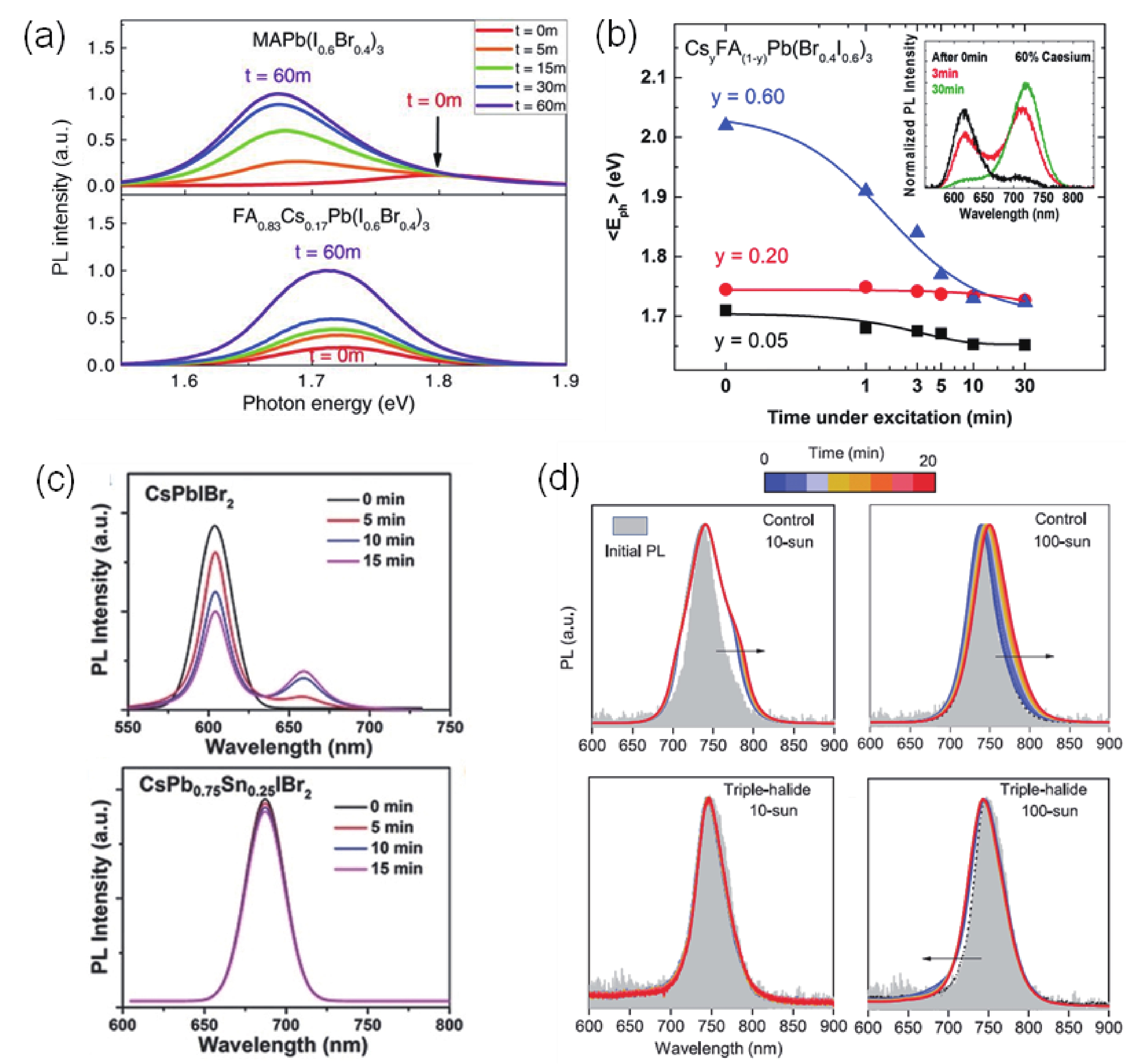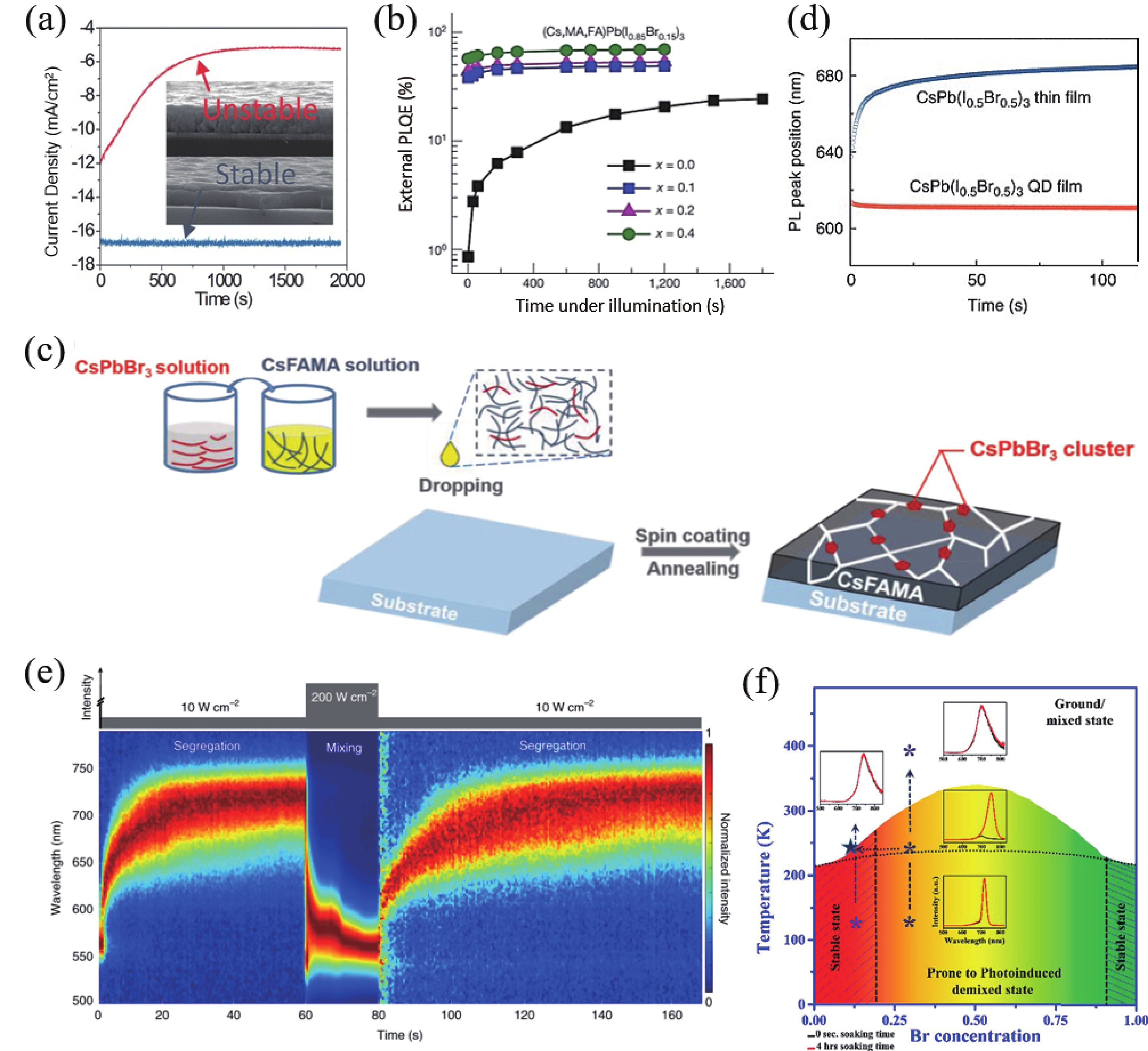| Citation: |
Lili Ke, Lixiu Zhang, Liming Ding. Suppressing photoinduced phase segregation in mixed halide perovskites[J]. Journal of Semiconductors, 2022, 43(2): 020201. doi: 10.1088/1674-4926/43/2/020201
****
L L Ke, L X Zhang, L M Ding, Suppressing photoinduced phase segregation in mixed halide perovskites[J]. J. Semicond., 2022, 43(2): 020201. doi: 10.1088/1674-4926/43/2/020201.
|
Suppressing photoinduced phase segregation in mixed halide perovskites
DOI: 10.1088/1674-4926/43/2/020201
More Information
-
References
[1] Guo Y, Yin X, Que W, et al. Toward mixed-halide perovskites: insight into photo-induced anion phase segregation. J Mater Chem C, 2020, 8, 14626 doi: 10.1039/D0TC03885G[2] Hoke E T, Slotcavagea D J, Dohner E R, et al. Reversible photo-induced trap formation in mixed-halide hybrid perovskites for photovoltaics. Chem Sci, 2015, 6, 613 doi: 10.1039/C4SC03141E[3] McMeekin D P, Sadoughi G, Rehman W, et al. A mixed-cation lead mixed-halide perovskite absorber for tandem solar cells. Science, 2016, 351, 151 doi: 10.1126/science.aad5845[4] Dang H X, Wang K, Ghasemi M, et al. Multi-cation synergy suppresses phase segregation in mixed-halide perovskites. Joule, 2019, 3, 1746 doi: 10.1016/j.joule.2019.05.016[5] Bischak C G, Hetherington C L, Wu H, et al. Origin of reversible photoinduced phase separation in hybrid perovskites. Nano Lett, 2017, 17, 1028 doi: 10.1021/acs.nanolett.6b04453[6] Rehman W, McMeekin D P, Patel J B, et al. Photovoltaic mixed-cation lead mixed-halide perovskites: links between crystallinity, photo-stability and electronic properties. Energy Environ Sci, 2017, 10, 361 doi: 10.1039/C6EE03014A[7] Li N, Zhu Z, Li J, et al. Inorganic CsPb1– xSn xIBr2 for efficient wide-bandgap perovskite solar cells. Adv Energy Mater, 2018, 8, 1800525 doi: 10.1002/aenm.201800525[8] Yang Z, Rajagopal A, Jo S B, et al. Stabilized wide bandgap perovskite solar cells by tin substitution. Nano Lett, 2016, 16, 7739 doi: 10.1021/acs.nanolett.6b03857[9] Xu J, Boyd C C, Zhengshan J Y, et al. Triple-halide wide-band gap perovskites with suppressed phase segregation for efficient tandems. Science, 2020, 367, 1097 doi: 10.1126/science.aaz5074[10] Hu M, Bi C, Yuan Y, et al. Stabilized wide bandgap MAPbBr xI3– x perovskite by enhanced grain size and improved crystallinity. Adv Sci, 2016, 3, 1500301 doi: 10.1002/advs.201500301[11] Abdi-Jalebi M, Andaji-Garmaroudi Z, Cacovich S, et al. Maximizing and stabilizing luminescence from halide perovskites with potassium passivation. Nature, 2018, 555, 497 doi: 10.1038/nature25989[12] Zhou W, Chen S, Zhao Y, et al. Constructing CsPbBr3 cluster passivated-triple cation perovskite for highly efficient and operationally stable solar cells. Adv Funct Mater, 2019, 29, 1809180 doi: 10.1002/adfm.201809180[13] Belisle R A, Bush K A, Bertoluzzi L, et al. Impact of surfaces on photoinduced halide segregation in mixed-halide perovskites. ACS Energy Lett, 2018, 3, 2694 doi: 10.1021/acsenergylett.8b01562[14] Draguta S, Sharia O, Yoon S J, et al. Rationalizing the light-induced phase separation of mixed halide organic-inorganic perovskites. Nat Commun, 2017, 8, 1 doi: 10.1038/s41467-016-0009-6[15] Yoon S J, Draguta S, Manser J S, et al. Tracking iodide and bromide ion segregation in mixed halide lead perovskites during photoirradiation. ACS Energy Lett, 2016, 1, 290 doi: 10.1021/acsenergylett.6b00158[16] Nandi P, Giri C, Swain D, et al. Temperature dependent photoinduced reversible phase separation in mixed-halide perovskite. ACS Appl Energy Mater, 2018, 1, 3807 doi: 10.1021/acsaem.8b00587[17] Jaffe A, Lin Y, Beavers C M, et al. High-pressure single-crystal structures of 3D lead-halide hybrid perovskites and pressure effects on their electronic and optical properties. ACS Cent Sci, 2016, 2, 201 doi: 10.1021/acscentsci.6b00055[18] Mao W, Hall C R, Bernardi S, et al. Light-induced reversal of ion segregation in mixed-halide perovskites. Nat Mater, 2021, 20, 55 doi: 10.1038/s41563-020-00826-y[19] Elmelund T, Seger B, Kuno M, et al. How interplay between photo and thermal activation dictates halide ion segregation in mixed halide perovskites. ACS Energy Lett, 2019, 5, 56 doi: 10.1021/acsenergylett.9b02265 -
Proportional views






 DownLoad:
DownLoad:















